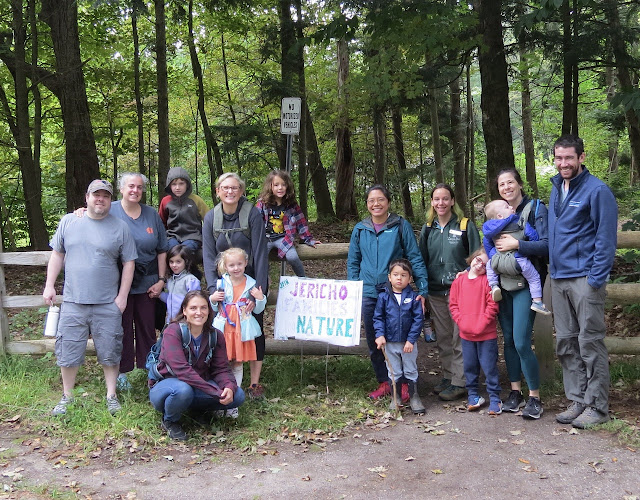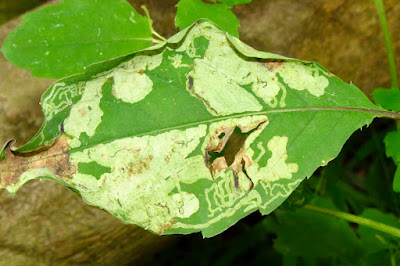Families met up with the JFiN (Jericho Families in Nature) team, at the Jericho Town Forest Starbird Dr trail entrance for an hour of exploration, and observation of nature.
Before we even stepped onto the trails we found items of interest worthy of a closer look.
Why do Jewelweed seed pods explode? – Sibley Guides
When the tiny pods are ripe the slightest touch causes them to snap open, flinging the seeds in all directions (scroll down to see a video). Hence, the alternate name is touch-me-not. The common explanation for this explosive seed-flinging is that it allows the plant to disperse its seeds more widely.
We notice that the Jewelweed leaves have been partially eaten. We suspect the culprit is the Jewelweed Leaf-miner Fly (Phytoliriomyza melampyga).Note that many of the observation photos with preliminary identifications are hot-linked to their iNaturalist posting. Click on the link to see if the ID has been confirmed and to read more about the plant or animal.
Just inside the split-rail fence we discover a large tree stump and wonder how old it is and what are the dimensions of this mighty elderly tree stump.
Since our tape measure is only 60 inches long, it takes some maneuvering and working together to measure all the way around the stump. First two people stretch the tape out going part way around it, then hold their fingers in place at the ends of the tape. Then two more people take the tape and measure from one finger holding the spot until the tape reaches its end. Then one more finger marks the end and the tape is again extended.
The final measurement is 160 inches around.
Now we measure across the top through the middle of the stump.
We find it to be 47 inches across.
Another tree has been observing us as we do our measurements.
 Some kind soul has placed a couple of signs alerting us to two patches of Eastern Poison Ivy (Toxicodendron radicans). T. radicans is commonly eaten by many animals and the seeds are consumed by birds.
Some kind soul has placed a couple of signs alerting us to two patches of Eastern Poison Ivy (Toxicodendron radicans). T. radicans is commonly eaten by many animals and the seeds are consumed by birds.
Our mantra when in nature is if you find yourself walking slow, walk slower.
This little creature was scampering slightly faster than the caterpillar, but still at a slow pace.
The eastern newt is a common newt of eastern North America. It frequents small
lakes, ponds, and streams or nearby wet forests. The eastern newt produces tetrodotoxin, which makes the species unpalatable to predatory fish and crayfish. It has a lifespan of 12 to 15 years in the wild, and it may grow to 5 in (13 cm) in length. The striking bright orange juvenile stage, which is land-dwelling, is known as a red eft. Some sources blend the general name of the species and that of the red-spotted newt subspecies into the eastern red-spotted newt (although there is no "western" one). - Wikipedia
The colors, shapes, textures, and other characteristics in nature tell us a lot about them as well as feed our visual and tactile interest.
Can you see an image of an angel or bird in this mushroom as I can?
Wait, didn't you say you went to the Jericho Town Forest?
There is no ocean in the Jericho Town Forest.
Why is there coral there?
No ocean, and no coral.
A small poke to this puff ball elicited tiny black silky spores like a puff of smoke.

Conifercone Cap (Baeospora myosura)
As a reminder, these IDS are awaiting verification.
Male pine cones do not make the hard-shelled woody case like the female pine cones do. They are soft and spongy. Female pine cones use their woody structure to keep their seeds safe. They keep their seeds safe so the seeds can hopefully be pollinated and grow. - The Secret Life of Pine Cones
Mushrooms can be found growing on a number of different hosts.
We learn from nature and from each other. Spotting some rainbow colors in a pool of water, Nadine told us about biofilm. A quick test to see if the scum is caused by a hydrocarbon-based oil is to grab a stick and poke it into the film. An oil slick will swirl back on itself in the wake of the stick, whereas a biofilm will fracture into small pieces that remain separated.
A biofilm comprises any syntrophic consortium of microorganisms in which cells stick to each other and often also to a surface. These adherent cells become embedded within a slimy extracellular matrix that is composed of extracellular polymeric substances. - Wikipedia
It is always good etiquette to drop off some interesting finds near any Troll bridges you pass. This is in appreciation of the Trolls keeping the bridges in good working order. Any good find will do - a half-chewed pine cone, a bird feather, a shiny small stone...
Abbey (DRML Librarian and JFiN team member) brought along and read us a book titled Can You Hug a Forest?
Abbey prompted us all: Of course, you can. First, you hug the air: open your arms, lift up your chin, and breathe in all the way down to your toes. Then you hug a leaf and a flower and a trail and a stream and all the other wondrous natural elements that make up a forest. Take every chance to soak in your natural surroundings and be grateful for nature. 
AND WE ALL DID SO INDEED!
We discovered many likely homes for creatures such as cavities in trees, and holes in the ground like this ant mound.
Looks like the Trolls have set out some Halloween decorations albeit a bit early.
View more of our observations from the Jericho Town Forest, here.
Gary Irish a local historian in Jericho offers this about the "Jericho Town Forest".
Jericho never had a town forest in the usual sense that many other towns do (such as Hinesburg, which a few years ago cut trees in the Hinesburg town forest and had the lumber milled into flooring which was used in the Hinesburg town hall). What you think of as the town forest had its origins in 1933 when the Village of Jericho water system was established by damming up Ford's Brook near its headwaters on the Leighton Rice property to create a reservoir from which water could be pumped to the incorporated village. This went from 30 users when the system was created to over 400 by 1983, and the spring-fed reservoir was no longer sufficient, so five deep wells were drilled to increase the water supply, along with an underground reservoir on Steeplebush Road, the higher elevation giving more pressure to the system. But by the late 1980s, with the development of Jericho East, the production of these wells dropped from 65 gallons per minute to 15 gallons per minute, so the decision was made to connect to the Champlain Water District. This process was completed in 1994, and, with the water district no longer having any use for the 39 acres of land that their system had occupied, they donated this land to the Town of Jericho for recreation use.
Apparently sometime after that, the name "Town Forest" was adopted for this area. I know several years ago, there was a move to take out the dam on the brook, but, having never been on this property in my life, I have no idea if that ever happened. Certainly, the town has never used it as a forest in the sense of harvesting trees. As to the origin of the trees, as I say, I have never been on the property, so I don't know if this was once farmland and thus likely open land, and the trees have just filled in over the years since the 1930s, or if they were something planted by the water system folks. But either way, they for the most part have likely been there for at least 90 years, and perhaps longer.
- Gary Irish
The Jericho Trails Committee is responsible for upkeep and Maintenance of the trail systems and peripheral hardware and buildings. Town Forestry is responsible for logging and Tree care. - Steve Schwartz (Jericho Trails Committee Chair).
To view photos of other past JFiN-hosted events, view the links on the right column of this blog under the title JFiN Families in Nature Events.
Upcoming walks- More walks are in the works. We will post on FPF and email this list with info.
What is JFiN?Read about it at Jericho Families in Nature (JFiN) Introduction
Remember to leave room for the wild things, and to visit nature often.
Liz, Bernie, Laura, and Abbey
JFiN Planning Team
JFiN Walk Guidelines -
*Stay with the group
*Be kind and caring to wildlife
*Pack in and pack out
*Ba a nature steward






























I can't imagine a nicer place to call "home" than Jericho as we know it at the present day. The commitment shown by the JiFN team is most impressive!
ReplyDeleteVery interesting and loved the pictures. I lived in Jericho in the 60's and the water was great. We lived on Lafayette Drive so the kids had their own nature playground.
ReplyDeleteNow after 26 years I live at 66Starbird , the gateway to the forest. Love the fence